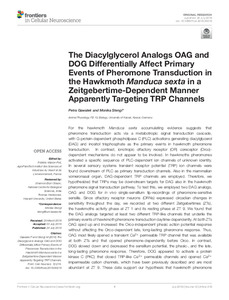| dc.date.accessioned | 2018-08-22T06:10:04Z | |
| dc.date.available | 2018-08-22T06:10:04Z | |
| dc.date.issued | 2018-07-24 | |
| dc.identifier.issn | 1662-5102 | |
| dc.identifier.uri | urn:nbn:de:hebis:34-2018082256283 | |
| dc.identifier.uri | http://hdl.handle.net/123456789/2018082256283 | |
| dc.description.sponsorship | Gefördert durch den Publikationsfonds der Universität Kassel | |
| dc.language.iso | eng | |
| dc.rights | Urheberrechtlich geschützt | |
| dc.rights.uri | https://rightsstatements.org/page/InC/1.0/ | |
| dc.subject | transient receptor potential ion channels | eng |
| dc.subject | insect olfaction | eng |
| dc.subject | olfactory transduction | eng |
| dc.subject | diacylglycerol | eng |
| dc.subject | tip recordings | eng |
| dc.subject | olfactory sensilla | eng |
| dc.subject.ddc | 570 | |
| dc.title | The Diacylglycerol Analogs OAG and DOG Differentially Affect Primary Events of Pheromone Transduction in the Hawkmoth Manduca sexta in a Zeitgebertime-Dependent Manner Apparently Targeting TRP Channels | eng |
| dc.type | Aufsatz | |
| dcterms.abstract | For the hawkmoth Manduca sexta accumulating evidence suggests that pheromone transduction acts via a metabotropic signal transduction cascade, with G-protein-dependent phospholipase C (PLC) activations generating diacylglycerol (DAG) and inositol trisphosphate as the primary events in hawkmoth pheromone transduction. In contrast, ionotropic olfactory receptor (OR) coreceptor (Orco)-dependent mechanisms do not appear to be involved. In hawkmoths pheromones activated a specific sequence of PLC-dependent ion channels of unknown identity. In several sensory systems transient receptor potential (TRP) ion channels were found downstream of PLC as primary transduction channels. Also in the mammalian vomeronasal organ, DAG-dependent TRP channels are employed. Therefore, we hypothesized that TRPs may be downstream targets for DAG also in the hawkmoth pheromone signal transduction pathway. To test this, we employed two DAG analogs, OAG and DOG for in vivo single-sensillum tip-recordings of pheromone-sensitive sensilla. Since olfactory receptor neurons (ORNs) expressed circadian changes in sensitivity throughout the day, we recorded at two different Zeitgebertimes (ZTs), the hawkmoths activity phase at ZT 1 and its resting phase at ZT 9. We found that the DAG analogs targeted at least two different TRP-like channels that underlie the primary events of hawkmoth pheromone transduction daytime-dependently. At both ZTs OAG sped up and increased the Orco-independent phasic action potential response without affecting the Orco-dependent late, long-lasting pheromone response. Thus, OAG most likely opened a transient Ca2+ permeable TRP channel that was available at both ZTs and that opened pheromone-dependently before Orco. In contrast, DOG slowed down and decreased the sensillum potential, the phasic-, and the late, long-lasting pheromone response. Therefore, DOG appeared to activate a protein kinase C (PKC) that closed TRP-like Ca2+ permeable channels and opened Ca2+ impermeable cation channels, which have been previously described and are most abundant at ZT 9. These data support our hypothesis that hawkmoth pheromone transduction is mediated by metabotropic PLC-dependent mechanisms that activate TRP-like channels as the primary event of pheromone transduction. In addition, our data indicate that at different times of the day different second messenger-dependent ion channels are available for pheromone transduction cascades. | eng |
| dcterms.accessRights | open access | |
| dcterms.bibliographicCitation | In: Frontiers in cellular neuroscience. - Lausanne : Frontiers Reseach Foundation. - July 2018, Volume 12, Article 218 | |
| dcterms.creator | Gawalek, Petra | |
| dcterms.creator | Stengl, Monika | |
| dc.relation.doi | doi:10.3389/fncel.2018.00218 | |

